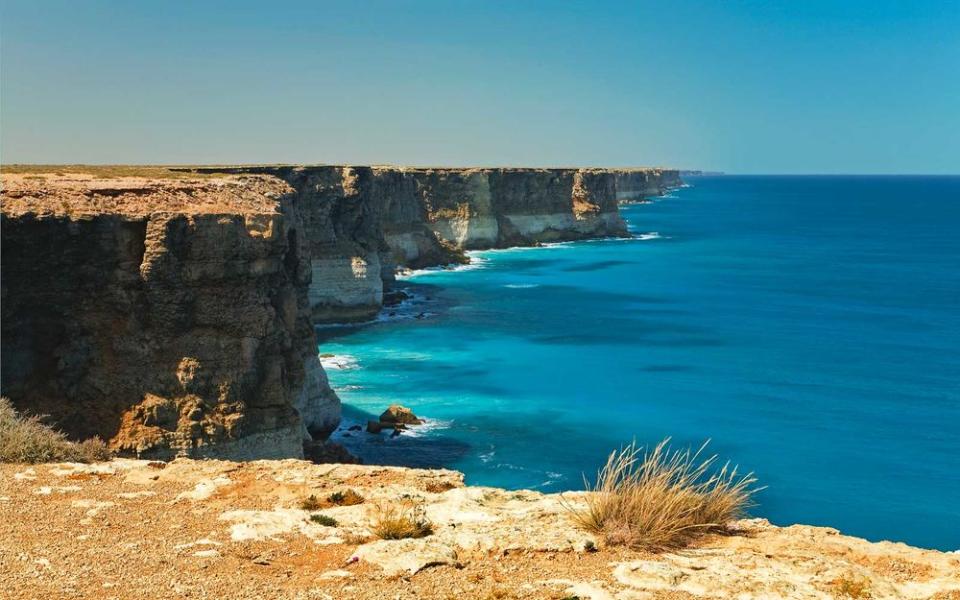Australia's Southern Coast Has Stunning Views and Incredible Wildlife You Won't Find Anywhere Else

One of the longest stretches of coastal cliffs in the world separates Australia from the turquoise waters of the Great Australian Bight. Here, along the country’s southern edge, is where you’ll find the “Galápagos of Australia,” home to more unique species than in all the Great Barrier Reef.
It’s a haven for endangered creatures like southern bluefin tuna and Australian sea lions, who play and feast in the surf and can’t be found anywhere else in the world. Southern right whales (named for being the “right” whale to harpoon and once hunted to the brink of extinction) raise their calves along the Great Australian Bight’s wide continental shelf, which at points reaches as far as 200 nautical miles out to sea.
The same waters support a $440-million aquaculture and fishing industry — not even half of what it earns for tourism. Landside, the great Nullarbor Plain casts its own dramatic spread, a vast flatness marked by the occasional tree and not much else, making the 300-foot sea cliffs that characterize this part of Australia all the more impressive by contrast.
The Great Australian Bight is one of Earth’s most fascinating, treasured regions — why, then, is it embroiled in controversy? Read on to find out.
The Great Australian Bight

A bight is simply a long and gradual coastal curve that creates a large bay, often with shallow waters. You’re likely already familiar with a number of bights — for instance, the area between Long Island and New Jersey on the East Coast is known as the New York Bight, while California’s Channel Islands live in the Southern California Bight, which stretches all the way from Santa Barbara to San Diego.
The Great Australian Bight, however, is one of the largest examples in the world, hence its name. It was formed some 65 million years ago at the end of the Cretaceous Period, when the continent separated from Antarctica and began its slow drift north.
While the exact area of the Great Australian Bight is up for debate, the most widely accepted definition plots its coast from the Eyre Peninsula in South Australia to Cape Pasley in Western Australia, about 720 miles as the crow flies and encompassing more than 28,000 square miles in the marine park alone.
What to Do
The Great Australian Bight is known for having what may just be the best whale watching in the world — even from land. In the far west corner of South Australia, there’s a viewing platform atop the famed Bunda Cliffs, which rise 300 feet above the sea. From here, at the Head of Bight, you can see as many as a hundred whales at once between July and August, though you’re guaranteed to see a whale anytime during the season, June through September. There are Great Australian Bight whale watching tours as well, but EP Cruises is the only operator licensed to take kayakers out among the pods.
But it isn’t all craggy sea cliffs. Great Australian Bight beaches are some of Australia’s best. Most are toward the eastern end of the Bight, where the Nullarbor cliffs give way to more accessible sand. While Baird Bay on the Eyre Peninsula in South Australia attracts families, while Venus Bay just to the south is prime for snorkeling in calm waters and watching dolphins. Save the fishing for nearby Mount Camel beach, where you can cast into schools of salmon from the beach. A few hours northwest, Cactus Beach gives experienced rippers a chance to get in some Great Australian Bight surfing on three powerful breaks — Cactus, Castles, and Caves — but check conditions before paddling out, as rip currents can be dangerously strong.
Controversy in the Great Australian Bight
It’s not only marine life that’s attracted to the Great Australian Bight — oil companies like Norway’s Equinor (formerly Statoil) have set their sights on what’s been called one of the last natural gas reserves in the world. Predictably, drilling for oil in the Bight is extremely controversial, though Australia has a long history of extracting natural resources from the land. Proponents claim that allowing drilling in the Great Australian Bight has the potential to bring lasting jobs and wealth to the area. Opponents worry that a spill — which would decimate the Bight’s veritable Eden and jeopardize the $1.6-billion tourism and fishing industries — is inevitable.
Of the 11 exploration permits granted by the Australian government since 2011, two have been awarded to Equinor, which released an environmental impact report in early 2019 that showed a major oil spill could affect thousands of miles of the Great Australian Bight’s coast. In response, surfers gathered at in Sydney at Bondi Beach to stage a peaceful protest in the form of a massive paddle out, a ceremony typically reserved for memorials. Other critics argue that the proposal in general takes too many chances — something that wouldn’t be allowed in Norwegian waters. BP was also awarded an exploration permit. However, the English company pulled out in 2016 after projecting mass environmental damage in the case of an accident, in part because the Bight’s waters are so remote that it would take more than a month to stop the flow of oil. Equinor had originally planned to begin drilling by the end of 2019 — whether that will happen remains to be seen.

